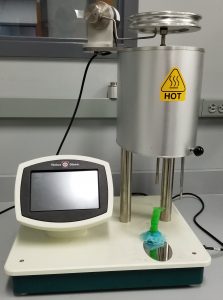Melt Flow Rate (MFR) is the mass of a polymer that flows through a capillary at a specified temperature and pressure during a measured time period. The MFR is the mass of polymer that flows during the test, normalized to 10 minutes. The calculated MFR value is related to molecular weight: the higher the MFR, the lower the molecular weight. MFR is also inversely proportional to viscosity: a melted material’s ability to flow when under pressure. Lastly, we can compare MFR values of a single material at different gravimetric weights in order to measure molecular weight distribution.

MFR is a common Quality Control and Production Control test for plastic resins and other materials in the plastic industry. It’s not the most comprehensive measure of molecular weight; “it is a single point determination of a molecular weight distribution, so it can be a misleading value. MFR does not provide any information on the distribution of molecular weights present or whether a factor other than molecular weight is influencing the flow rate,” Jarret Wright, our Thermal, Physical, & Microscopy Lab Manager, explained. However, it’s a fairly quick and simple test, which makes it ideal for quickly and efficiently comparing batches of the same material to ensure consistency. “It is useful for verifying if a resin meets a specification, or to determine if there are gross differences between two samples.”
Some of the common purposes for performing the Melt Flow Rate test are:
- Comparing materials for product development
- Evaluating samples from new material suppliers
- Estimating flow properties for simple extrusion processes
- Predicting a polymer’s behavior for certain processing techniques
- Quick comparisons for quality and production control
- Conformance of a material to a Certificate of Analysis
- Grade differentiation of materials
To perform the MFR test a small portion of the material–usually in pellet or powder form–is placed into a heated barrel, where it melts into a viscous fluid. A portion of the sample is extruded through a capillary die by a deadweight piston over the course of a set time frame. The volume of the sample that exits the instrument during that time period is measured, either by the instrument or manually. Results are generally reported in terms of grams per 10 minutes.
“Different temperature and weight combinations are recommended for specific polymer types, or in some cases, for comparative analyses, we’ve chosen conditions based on our experience when no specific conditions are called out,” Jarret explained. “In that way, it is similar to dilute solution viscosity (DSV), but I would not expect there to be a specific conversion between the two. We generally request a large sample amount for MFR (about 50 grams is preferred, but we can work with less), whereas DSV uses on the order of a few hundred milligrams.”
ASTM D1238 and ISO 1133 are the most common standards for melt flow tests, as they define both equipment specifications and test methods. Test parameters are always reported with the results, because various weights and temperatures are suggested for different material types.
At SGS PSI, we use a Tinius Olsen MP1200 for our MFR tests and have years of experience in this field. Some of the work we’ve done using this test includes raw material certification, batch-to-batch comparisons, and grade differentiation of materials. If you’re facing a materials testing challenge, contact us today!
